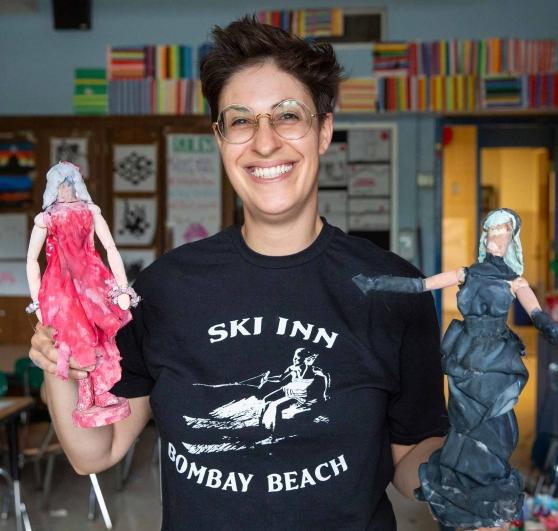Fostering pride in creativity

Jennifer Figueroa's students at PS 178 created doll-sized replicas of the gowns they saw at the Met Gala.
Jennifer Figueroa believes that anyone can be an artist. And the Bronx native, now in her third year of teaching art at PS 178 in Co-op City, knows that an expansive definition of “artist” helps kids take pride in all kinds of creativity.
“When kids think of an artist, they think of someone painting in a room,” Figueroa says, which can be limiting for students who don’t consider themselves good at drawing or painting.
“But I try to convey to them that art is so much bigger,” she says. “If you can paint and draw, great! You’re an artist. But if you can put together an amazing outfit, you’re also an artist. If you can make a playlist for a party, you’re an artist.”
Figueroa chose her first career, as a paraprofessional, in part because it gave her the flexibility to make her own art. But after 12 years, she realized she was ready for a change and took advantage of the UFT’s Leap to Teacher program, a collaboration with CUNY to support paraprofessionals making the transition to teaching. She graduated from Lehman College with a BA in sculpture and a master’s in arts education.
Now the art teacher at PS 178, where she was previously a para for 10 years, “Ms. Fig” devotes herself to cultivating a new generation of artists and appreciators of art.
“Exposing these kids to the art in New York City is really important to me,” Figueroa says. As the child of Puerto Rican parents who were “not museum-goers,” Figueroa had little opportunity to appreciate the city’s art world until she attended the HS of Art and Design in Manhattan.
“My mind was kind of blown when I went to high school,” she says. “I didn’t know these things existed!”
She made it a goal, in the 2022–23 school year, to get every one of her classes to the Metropolitan Museum of Art. “I want to cultivate people who go to museums and who are excited about art,” she says. “I want lifelong art lovers.”
Figueroa designs her units to support this “everyone is an artist” philosophy. Over the course of a year, students might study fashion, animation, culinary arts, calligraphy, sculpture and print-making. By expanding her classroom projects beyond just painting and drawing, Figueroa says, every student gets a chance to make something they’re proud of.
A big hit was the fashion unit, for which students designed and built doll-size replicas of the gowns they saw at the Met Gala, including Lady Gaga’s “meat dress.”
For a unit on vernacular architecture, which is rooted in local building traditions and materials, students examined the structure of homes in specific places, such as pole houses in Hawaii. She asked them big-picture questions such as: “Why might this design be practical for this climate? Why would the people in this culture build their houses this way?” She does so to spark awareness of cultures beyond their own.
“I want everybody to get an idea of what’s happening in the world,” she says.
Despite the demands of full-time teaching, Figueroa hasn’t abandoned her own artistic practice. She does print-making and exhibits her work when she can. She hopes that her deep love of art and enthusiasm for teaching is an inspiration for her students.
She describes one art-resistant child who’d received a low grade in art the previous year, but with scaffolded instruction and one-on-one support began to thrive.
“It was cool,” she says, “to see him go from ‘oh, art again,’ to ‘Ms. Fig, I can’t wait to work on that project.’”